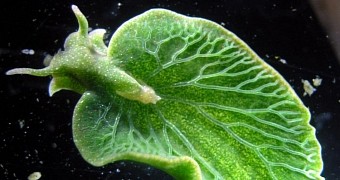As hard to believe as this might be, the fact of the matter is that the green slimy thing featured in the photo accompanying this article is not a sample of the Hulk's snot. It's actually a slug. A sea slug that goes by the name of Elysia chlorotica, to be more precise.
What's super cool about these marine dwellers is the fact that, if need be, they can survive on nothing but sunlight for several months in a row. This is because, just like plants, Elysia chlorotica specimens are capable of photosynthesis.
How a sea slug evolves to feed on sunlight
According to scientists with the Marine Biological Laboratory, a center for research and education in the US, these sea slugs owe their ability to feed on sunlight much like plants do to the fact that, when eating algae, they steal some of their genes and even specialized structures dubbed chloroplasts.
The researchers go on to argue that, having carried out a series of experiments and investigations in laboratory conditions, they found that these genes that the sea slugs get from the algae they feed on serve to sustain photosynthetic processes inside the body of the marine dwellers.
More precisely, evidence indicates that one of these genes produces an enzyme that supports the activity of the stolen chloroplasts, which in turn produce carbohydrates and lipids. In doing so, the chloroplasts can keep the sea slugs alive for several months in a row.
Interestingly enough, it appears that this hijacked gene that keeps the algae chloroplasts up and running in the body of Elysia chlorotica specimens can be passed on from one generation to another. This means that baby slugs need only get a few chloroplasts to become self-sufficient.
“The gene is incorporated into the slug chromosome and transmitted to the next generation of slugs. While the next generation must take up chloroplasts anew from algae, the genes to maintain the chloroplasts are already present in the slug genome,” says researcher Sidney K. Pierce.
“There is no way on earth that genes from an alga should work inside an animal cell. And yet here, they do. They allow the animal to rely on sunshine for its nutrition. So if something happens to their food source, they have a way of not starving to death until they find more algae to eat,” he adds.
These slugs' survival tricks could transform medicine
Presently, a whole lot of scientists are looking into the possibility of transferring various genes from one multicellular species to another. The end goal is to develop new therapies that can treat the genetically based diseases that affect millions of people worldwide.
Sidney K. Pierce and fellow researchers believe that, by studying Elysia chlorotica in further detail, scientists might just get a better idea of how gene transfers from one species to another can come to happen. This would pave the way for the development of the gene theories they wish to roll out in the near future.

 14 DAY TRIAL //
14 DAY TRIAL //